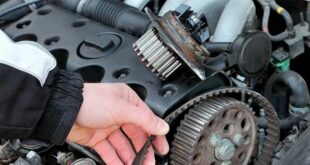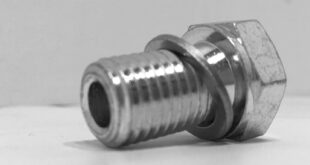Changing a defective or worn tension pulley can initially seem like an insurmountable challenge. The component plays a crucial role in the vehicle's belt drive system by maintaining the correct tension of the dental or V-ribbed belt ensures. A correctly functioning tensioner pulley is essential for the performance and longevity of the engine's auxiliary components. Our instructions give you an overview of how the change is carried out, but please note that the process can vary from vehicle to vehicle and is also more aimed at older vehicles.
Steps to change the tensioner pulley:
- Take safety precautions: Make sure the vehicle is on a level surface and the engine has cooled down. Apply the handbrake and disconnect the battery to avoid any risk of electrical discharge.
- Provide access to the belt drive: On most vehicles, the toothed or V-ribbed belt can be accessed via the front of the engine. Remove any components that prevent access to the tensioner pulley.
- Release tension on the belt: The tensioner that applies pressure to the tensioner pulley must be locked or relaxed so that the belt can be loosened and then removed.
- Removing the old clamping unit: After loosening the belt you can entire clamping unit Remove (tensioner roller and tensioner). It is important that both the idler pulley and tensioner are checked and replaced if necessary.
- Installation of the new clamping unit: Insert the new idler pulley and tensioner. Make sure they are positioned correctly to ensure optimal function.
- Reinsert belt: Place the belt loosely over the corresponding pulleys. Make sure the belt is seated correctly in all grooves of the pulleys.
- Adjust the tension of the belt: Release the lock from the tensioner so that the new tensioner pulley presses against the belt and creates the correct tension. In many cases, further manual tensioning is not necessary.
- Review: After the belt and tensioner unit are installed, it is important to perform an inspection. Check whether the belt is seated correctly and the tension pulley is working properly.
- Assembly of the removed components and final test: Reassemble all previously removed components. Reconnect the battery and start the engine to test if everything is working correctly.
Why leave the change to a professional?
Although our instructions provide a general overview, it is recommended that you leave the tensioner pulley replacement to a professional. The exact installation and correct settings of the tension pulley are crucial for the running of the engine and the function of the auxiliary units. In addition, the tension roller is used in specialist workshops always together with the belt changed, which increases the reliability and safety of the vehicle. Changing the Tension pulley and belt in a workshop not only slightly impacts the cost of materials, but also ensures that your engine is back up to standard when it comes to these critical components.
Task of the tension roller in the belt drive
- The tension pulley is an important element in the Belt drive of the vehicle. Their main task is to ensure constant tension on the timing belt or V-ribbed belt. This is necessary in order to ensure optimal power transmission to the auxiliary units such as alternator, Air conditioning compressor or water pump to enable. The roller presses the outside of the belt with precisely measured pressure, ensuring consistent tension and precise running. The shaft of the tension pulley is suspended on a spring mechanism that creates the necessary tension.
Tension pulley defects and symptoms
- A slipping or squeaking one Belts is a common sign of decreasing tension pulley spring force or signs of wear such as rust and cracks. Grinding or rattling noises from the engine compartment may indicate incorrect adjustment of the tensioner pulley. Problems with that Tension roller arm, such as corrosion or contamination, as well as defects in the vibration damper or spring torque can lead to excessive vibration of the roller arm. A squeaking or rattling noise can also be due to a defect in the pulley or pulley bearing.
Don't wait to change the tension pulley
- Do not ignore the symptoms of an impending tensioner pulley replacement. A V-belt that is too loose can lead to excessive wear, high temperatures and failure of the auxiliary components. Too much tension can cause similar damage. Defects in the tension roller require immediate attention and should not be postponed until the next inspection. Due to the complexity of installing, tensioning and adjusting the tension roller, it is recommended that you commission a specialist workshop to change it.
Cost of changing the tension pulley
- The cost of changing the tensioner pulley varies significantly between different car brands such as VW, Mercedes, BMW, Opel, Peugeot etc. as every engine compartment is different and the engines, auxiliary units and the V-belts differ in length and width. Additional spare parts and the region of the workshop can also influence the costs. As a rough guide you can use one Duration of about an hour In most cases two hours should be enough, assuming there are no other defects. The costs of changing the tension pulley should not be spared, as possible consequential damage can be significantly more expensive.
Why you should leave the change to an expert
- Changing the tension pulley and the associated belt should always be carried out by a professional due to the importance for the smooth operation of the auxiliary units and the potential consequential damage if handled incorrectly. Specialist workshops Not only do they offer the necessary know-how, but they also usually always change the tension pulley together with the belt, which increases the reliability and safety of the vehicle.
The following note is essential: For safety reasons, tuningblog recommends all repair, inspection and maintenance work exclusively to be carried out in a specialist workshop! Although our information is summarized to the best of our knowledge and belief, we cannot assume any liability for the content. All information is therefore "without guarantee".
That wasn't it yet!
In our Auto Repair Category you will find advice and instructions on common vehicle defects, repairs and the installation of accessories/tuning parts.
 tuningblog.eu Your magazine about tuning the car
tuningblog.eu Your magazine about tuning the car




